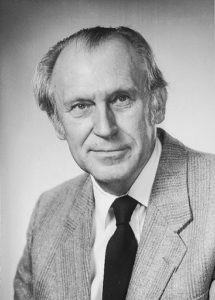Dr. Stephen Szára (born 1923) was a Hungarian biochemist and psychiatrist. Although DMT was first synthesized in 1931 by Dr. Richard Manske, Dr. Szára was the first person to uncover its psychotropic qualities. Through studies on volunteer human subjects, Dr. Szára investigated the role of psychedelics in psychotherapy and the ways in which DMT and other tryptamines might influence psychoses.
Dr. Szára earned his DSc and medical degrees from the University of Budapest. In 1953, he helped establish a research laboratory at a local psychiatric hospital.
According to a 2007 publication of his, Dr. Szára’s interest in psychoactive drugs was inspired by the discovery of LSD, and Aldous Huxley’s The Doors of Perception (1954), and new theories on a biochemical basis of schizophrenia.1 Dr. Szára ordered LSD from Sandoz Pharmaceuticals, wanting to see what the drug could illuminate about schizophrenia. In his book, DMT: The Spirit Molecule, Rick Strassman wrote that Sandoz declined Dr. Szára’s request due to concern about the substance being in the possession of a person in a Communist country. Without access to LSD, Dr. Szára pivoted his investigations toward other psychoactive substances. Curious to experience mescaline’s effects first hand, Dr. Szára took 400mg on Christmas Day in 1955.
About six months later, having learned about the spiritual use of cohoba snuff (which contains bufotenine and DMT) by indigenous South American tribes,2 Dr. Szára decided to explore DMT’s effects. He extracted it from Mimosa hostilis and injected himself and his Budapest laboratory colleagues with it.3 In a 2014 interview with Andrew Gallimore and David Luke of Reality Sandwich, Dr. Szára described his first experimental administration: “I tested three doses intramuscularly, paced at least two days apart to allow the drug to clear my body. The first dose (30 mg, around 0.4 mg/kg) elicited some mild symptoms – dilation of the pupils and some coloured geometric forms with closed eyes were already recognizable. Encouraged by these results, I decided to take a larger dose (75 mg, around 1.0 mg/kg), also intramuscularly. Within three minutes the symptoms started, both the autonomic (tingling, trembling, slight nausea, increased blood pressure and pulse rate) and the perceptual symptoms, such as brilliantly coloured oriental motifs and, later, wonderful scenes altering very rapidly.”
Dr. Szára said of the common phenomenological content his subjects shared, “When these experiences, such as God, strange creatures and other worldliness, appeared in our DMT studies, we did not philosophize about them but, as psychiatrists, we simply classified them as hallucinations.” He also theorized, “What DMT might do in adults is to slow down and stop reality testing (via the fronto-parietal loop) and let the Default Mode Network release the stored images and symbols into the perceptual system. It is the brain that stores and releases archetypal images into our altered consciousness…”
Dr. Szára immigrated to the United States after the 1956 Hungarian Uprising. In 1957, he began work at St. Elizabeth’s hospital with Joel Elkes at the National Institutes of Mental Health (NIMH), then worked for two years in Julius Axelrod’s laboratory.4 Over the next decade, Dr. Szára studied the metabolism of DMT in healthy and schizophrenic subjects and explored the biochemical processes of DMT, DPT, and DET, shedding light on typical brain functioning and brain functioning during altered states of consciousness.5-9 Several of Dr. Szára’s first studies are summarized in a Psychedelic Science Review article on early clinical research on DMT.
In 1968, Dr. Szára joined the Center for Studies of Narcotics and Drug Abuse where he served as Chief of Clinical Studies and conducted research on marijuana and THC. When NIMH expanded to create the National Institute on Drug Abuse (NIDA) in 1974, he became Chief of NIDA’s Biomedical Branch.
Dr. Szára has received several honors for his contributions. In 1984, he earned the Administrator’s Meritorious Achievement Award from the Alcohol, Drug Abuse, and Mental Health Administration (now the Substance Abuse and Mental Health Services Administration, or SAMHSA). In 2005, he earned the Kovats Medal of Freedom from the American Hungarian Federation and two years later became an honorary member of the Hungarian Association of Psychopharmacology. He is also an Emeritus Fellow of the American College of Neuropsychopharmacology.
More about Dr. Szára’s work can be found on his ResearchGate profile and in a video interview by the late Leo Hollister, professor emeritus of pharmacology and psychiatry at the University of Texas Medical School and Stanford University School of Medicine.
